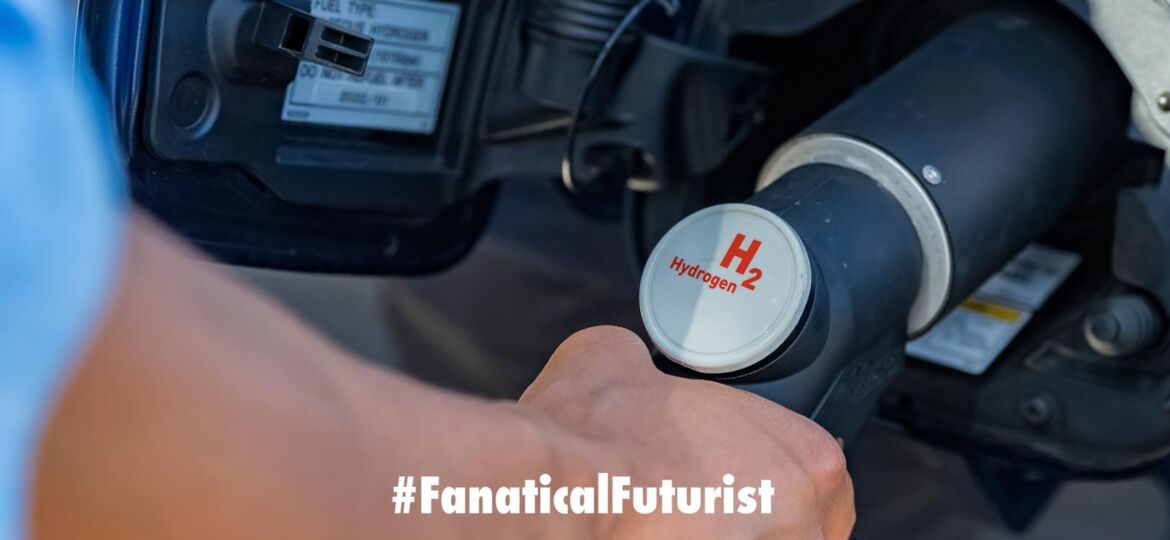
WHY THIS MATTERS IN BRIEF
While most companies are betting big on electric vehicles some are now spreading their bets just in case.
 Love the Exponential Future? Join our XPotential Community, future proof yourself with courses from XPotential University, read about exponential tech and trends, connect, watch a keynote, or browse my blog.
Love the Exponential Future? Join our XPotential Community, future proof yourself with courses from XPotential University, read about exponential tech and trends, connect, watch a keynote, or browse my blog.
Volkswagen, following in the footsteps of Toyota, has announced they’re developing a new hydrogen fuel cell that’s much cheaper than existing ones and have said that we could soon see a car travel more than 2,000km on a single tank – provided that is that the owners of the vehicle can find somewhere to fill their shiny new tanks in the first place, something that Toyota and others are working on as we speak. They’ve also just applied for a patent for their new fuel cell which is cheaper to produce than existing solutions.
The news represents a significant U-turn by Volkswagen. Like Elon Musk does every time he has the opportunity, the German manufacturer’s CEO, Herbert Diess, denied the potential of hydrogen as a power source for electric cars in a tweet published in May 2022 saying: “It has been shown that the Hydrogen car is not the solution to climate problem. In transport, electrification has taken over. Fake debates are a waste of time. Please listen to the science.”
The patent application for their new fuel cell, developed together with the German company Kraftwerk Tubes, also shows that Volkswagen has decided to play it safe and not have all its eggs in one basket with Lithium-Ion electric vehicles.
The huge batteries of electric cars are accumulators of electricity that is released according to the needs of the vehicle. Hydrogen fuel cells, by contrast, are capable of generating their own electricity.
For this they need a high-pressure tank that stores the hydrogen in gas form – if it were liquid it would need to be stored at very low temperatures – and a fuel cell that converts hydrogen into electricity.
Fuel cells also have an anode and a cathode like batteries. Hydrogen enters through the anode and passes through an electrolyte membrane which is responsible for dividing hydrogen (H2) into a proton (H+) and an electron (e-). An electrolyte then causes them to take different paths to the cathode.
The electrons go through an external circuit creating a flow of electricity—which is what makes the car’s engine work—while the protons pass through the electrolyte to the cathode. There they unite with oxygen, which enters directly to the cathode, and with the electron, producing water and heat. However, Volkswagen and Kraftwerk’s fuel cell puts a spin on materials traditionally used for membranes.
Sascha Kühn, Kraftwerk CEO explains in an interview: “The main difference with Hyundai and Toyota hydrogen cells is that [we] use a ceramic membrane instead of the usual plastic one. That’s a big difference. The big advantage of our solution is that it can be produced much cheaper than polymer fuel cells and it does not require any type of platinum,” a precious metal that makes the final cost of the product more expensive.
This technology, Kühn says, resembles solid-state batteries. According to the executive, both have almost the same electrolytes and a similar material structure. The difference is that, while solid-state batteries use a compact material to store energy, in fuel cells that role is assumed by hydrogen in gas form.
In addition, the new ceramic membrane, says Kühn, does not need to be moistened, so it does not freeze in winter, dry out in summer, or attract mold. The manager also points to another advantage that will save costs in the manufacture of vehicles: the fuel cell generates heat that can be used both to replace the car’s heating and air conditioning, which would also mean greater energy savings.
Although this patent has been requested together with Volkswagen, Kraftwerk assures that it can be used by other vehicle brands aswell: “Regardless of the manufacturer, our goal is for our technology to be launched in a series vehicle by 2026. We are talking about series of about 10,000 vehicles, spread over several car manufacturers,” says the CEO of Kraftwerk.
“Lithium is definitely not a way forward. Solid-state battery would be an option, but it’s not there yet,” explains Kühn, who sees his technology as an alternative for drivers who don’t have a suitable charging option on the go, at home, or do not want to waste their time at charging stations. According to the executive, with his system “we can travel up to 2,000 kilometers with a single tank of fuel.”
















